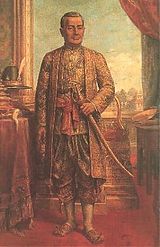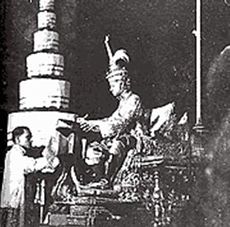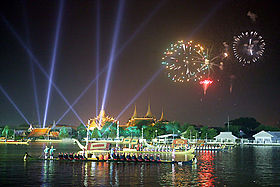- Monarchy of Thailand
-
King of Thailand Monarchy 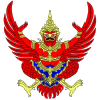
Emblem of Thailand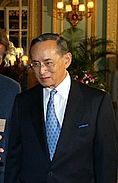
Incumbent:
Bhumibol Adulyadej (Rama IX)Style: His Majesty Heir apparent: Maha Vajiralongkorn First monarch: Sri Indraditya of Sukhothai Formation: 1238 Thailand 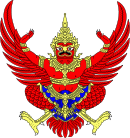
This article is part of the series:
Politics and government of
ThailandMonarchyRelated issues
The Monarchy of Thailand (also referred to as the King of Thailand or historically as King of Siam) (Thai: พระมหากษัตริย์ไทย) refers to the constitutional monarchy and monarch of the Kingdom of Thailand (formerly Siam). The King of Thailand is the head of state and head of the ruling Royal House of Chakri. The king's power is limited to being a symbolic figurehead, but the institution commands the respect and reverence of the Thai people.[1]
The current monarch of Thailand is His Majesty King Bhumibol Adulyadej. The king has reigned since 9 June 1946, making him the world’s longest reigning current monarch and the world’s longest serving head of state. Most of the king’s powers are exercised by his elected government in accordance with the current post-coup constitution. The king still retains many powers such as: being head of the Royal Thai Armed Forces, the prerogative of royal assent and the power of pardon. He is also the defender of the Buddhist faith in Thailand.
Since the end of the absolute monarchy in 1932, each constitution has maintained the king as "enthroned in a position of revered worship and shall not be violated." His Majesty, however, in his 2005 national birthday broadcast, specifically indicated he was unhappy with the provision and wanted to be violated and criticized. Despite this royal wish, Thai state authorities have steadfastly refused to permit not just criticism but what they deem to be inappropriate discussion. The constitution exempts the king and the royal family from legal actions, but confers no other legal rights. Therefore, the monarchy is protected against any physical or defamatory threats. This provision against defaming the monarchy is known in the West as the lèse majesté law.[2] Violations of this law have led to arrests of travelers to Thailand who have been alleged to have made disparaging comments or been linked to deemed-to-be disparaging information on the internet.[3]. To date legal scholars and law firms in Thailand have been totally reluctant to challenge the constitutional nature of the lese majeste law, which is in part linked closely with another often abused criminal code provision - that dealing with criminal defamation.
The king is assisted in his work and duties by the Private Secretary to the King of Thailand and the Privy Council of Thailand, in consultation with the head of the cabinet, the Prime Minister. In accordance with the constitution the king is no longer the originator of all laws in the kingdom; that prerogative is entrusted to the National Assembly of Thailand. All bills passed by the legislature, however, require his royal assent to become law. The monarchy's household and finances are managed by the Bureau of the Royal Household and the Crown Property Bureau respectively, these agencies are not considered part of the Thai government and all personnel are appointed by the king.[4]
The heir apparent to the Thai monarchy is the Crown Prince of Thailand, Prince Maha Vajiralongkorn. The succession to the throne is governed by the 1924 Palace Law of Succession, promulgated by King Vajiravudh. The rule of succession is male agnatic primogeniture, where only males are accepted and inheritance is between male lines, from father to son. However, the last two Constitutions of Thailand included provisions to permit for the amendment of the Palace Law to allow females to succeed. This seems unlikely with the birth of Prince Dipangkorn Rasmijoti in 2005, yet scholars continue to debate the subject.
The Thai monarchy has been in continuous existence since the founding of the Kingdom of Sukhothai in 1238. The institution reached its current constitutional form in 1932 after a coup revolution, which ended the absolute monarchy. The monarchy's official residence is the Grand Palace in Bangkok, Thailand. However the present king spends most of his time at the Chitralada Palace (also in Bangkok) and the Klai Kangwon Villa in Hua Hin.
Contents
History
 Pho Khun Ramkhamhaeng the Great
Pho Khun Ramkhamhaeng the Great
Origin
The current concept of Thai kingship has evolved through 800 years of absolute rule, and in contemporary times, especially after the 2006 coup, has become the subject of generally secret debate and watchful state spying. The first king of a unified Thailand was the founder of the Kingdom of Sukhothai: King Sri Indraditya in 1238. The idea of this early kingship is said to be based on two concepts derived from Hinduism (which the Thais inherited from its previous rulers the Khmers) and Theravada Buddhist beliefs. The first concept is based on the Vedic-Hindu caste of “Kshatriya” (Thai: กษัตริย์), or warrior-ruler, in which the king derives his powers from military might. The second is based on the Theravada Buddhist concept of “Dhammaraja” (Thai: ธรรมราชา), Buddhism having been introduced to Thailand somewhere around the sixth century A.D. The idea of the Dhammaraja (or kingship under Dharma), is that the king should rule his people in accordance with Dharma and the teachings of the Buddha.
These ideas were briefly replaced in 1279, when King Ramkhamhaeng came to the throne. Ramkhamhaeng departed from the Khmer tradition and created instead a concept of “paternal rule” (Thai: พ่อปกครองลูก), in which the King governs his people as a father would govern his children.[5] This idea is reinforced in the title and name of the King, as he is still known today, Pho Khun Ramkhamhaeng (Thai: พ่อขุนรามคำแหง) (“Pho” is Thai for Father). However this lasted only briefly, by the end of the kingdom the two old concepts had returned as symbolized by the change in the style of the kings; “Pho” was changed to “Phya” or Lord.
Kings of Ayutthaya
The Kingdom of Sukhothai was eventually supplanted by the Kingdom of Ayutthaya, which was founded in 1351 by King Ramathibodhi I. During the Ayutthayan period the idea of kingship changed. Due to ancient Khmer tradition in the region, Hindu concept of kingship was applied for the status of the leader. Brahmins took charge in the royal coronation. The king was believed to be the reincarnation of Hindu gods. Ayutthaya historical documents show the official titles of the kings in great variation; Indra, Shiva and Vishnu, or Rama. Seemingly, Rama was the most popular, as in 'Ramathibodhi'. However, Buddhist influence was also evident as many times the king's title and 'unofficial' name related to Bodhisattava, Dhammaraja, or King of Dharma, and the 'sprout of Buddha'. The two former concepts were re-established, with a new third concept taking a more serious hold. This new concept was called “Dhevaraja” (Thai: เทวราชา) (or Divine-King), which was an ideal borrowed from Hinduism and especially the Brahmins. This concept centered on the idea that the king was an incarnation (Avatar) of the god Vishnu and that he was a Bodhisattva (enlightened one), therefore basing his power on his religious power, moral power and purity of blood.
The king, portrayed by state interests as a semi-divine figure, then became - through a rigid cultural implementation - an object of worship and veneration to his people. From then on the monarchy was largely removed from the people and continued under a system of absolute rule. Living in palaces designed after Mount Meru (Home of the gods in Hinduism), the kings turned themselves into a “Chakravartin” or literally from Sanskrit "whose wheels are moving", where the King became an absolute and universal lord of his realm. Kings demanded that the universe be envisioned as resolving around them, and expressed their powers through elaborate rituals and ceremonies. For four centuries these kings ruled Ayutthaya, presiding over some of the greatest period of cultural, economic and military growth in Thai History.
Sakdina and Rachasap
The kings of Ayutthaya; especially King Trailokanat created many institutions to support their rule such as the bureaucracy and a system of Sakna or Sakdina, (ศักดินา: literally, power over fields' but usually translated as feudalism; and the creation of “Rachasap” ({{lang-th|ราชาศัพท์} Royal Thai) reserved exclusively for addressing the king or talking about royalty. The king’s power was absolute and sovereign: as the “Lord of the Land” ({{lang|th|พระเจ้าแผ่ดิน} Phra Chao Phaendin) and Lord of Life (เจ้าชีวิต Chao Chevit). The king was also the chief administrator, chief legislator and chief judge. Therefore all laws, orders, verdict and punishments theoretically originated from his person. All of this came to an end in 1767 when a Burmese army under the Alaungpaya Dynasty invaded, sacked and burned the city of Ayutthaya.
Chakri Kings
After a brief interlude filled first by civil war then the short-lived Thonburi Kingdom under King Taksin. In 1782 a new kingdom was established by King Buddha Yodfa Chulaloke (or Rama I) and moved the capital from Thonburi to Bangkok. King Rama I also founded the House of Chakri, the current ruling house of Thailand.
During the Rattanakosin Period the Chakri kings tried to continue the concepts of Ayutthayan kingship once again emphasizing the connection between the sovereign and his subjects. On the other hand they continued to not relinquish any authority of the throne. During this period (King Rama II, Rama III and Rama IV) tried to create the first semblance of a modern government, creating ministries and appointing chief ministers to help with the running of the government. Most notable of these was Somdet Chao Phraya Prayurawongse and Si Suriyawongse, who both acted as Chief Ministers for King Mongkut and (as regent until 1873) to King Chulalongkorn, respectively.
King Chulalongkorn (or Rama V) ascended the throne as king of Siam in 1868. King Chulalongkorn; himself educated by westerners, was intent on reforming the monarchy along western lines. First he abolished the practice of kneeling and crawling in front of the monarch [a practice reinstated under the 9th Dynasty] and repealed many laws concerning the relationship between the monarch and his people. Instead he created a monarchy based on western lines of an ‘enlightened ruler’; absolute but enlightened. However he continued to preserve many ancient aspects and rituals of the old kingship, including his religious and feudal powers. In 1874 the King created a privy council, copied from the European tradition to help him rule his Kingdom. During his reign Siam was pressured to relinquished control of it old tributaries of Laos and northern Malaya to Western powers, Siam itself narrowly avoided being colonized. His son King Vajiravudh (or Rama VI) (succeeded in 1910) continued his father’s zeal for reform and brought the monarchy into the 20th century. He was succeeded by his brother King Prajadhipok (or Rama VII) in 1925.
Change
In June 1932, a group of foreign educated students and military men called “the Promoters” carried out a bloodless Revolution, seizing power and demanded that King Prajadhipok, grant the people of Siam a constitution. The king agreed and in December 1932 the people were granted a constitution, ending 150 years of absolute Chakri rule. From then on the role of the monarch was relegated to that of a symbolic head of state. His powers from then on was exercised by the Prime Minister and the National Assembly
In 1935 King Pradhipok abdicated the throne, following disagreements with the increasingly authoritarian government. Rama VII lived in exile in the United Kingdom until his death. The king was replaced by his young nephew Ananda Mahidol (or Rama VIII). The new king was 10 years old and was living abroad in Switzerland; a council of regents was appointed in his place. During this period the roles and powers of the King was entirely usurped by the fascist government of Pleak Phibulsonggram, who aligned Siam on the side of the Axis powers during the Second World War. By the end of the war Phibulsonggram was removed and the young King returned. During the War many of the King's relatives were part of the Free Thai movement, which provided resistance to foreign occupation during the war and helped rehabilitate Thailand after the war.
After the Rama VIII’s mysterious death in 1946 his brother, Prince Bhumibol Adulyadej (or Rama IX), aged 19 years old, became the new monarch, Rama IX. To date he is the world's longest still-serving Head of State and longest reigning monarch (of current monarchs still serving).
Beginning approximately in 2000, the role of the Thai monarchy was increasingly addressed by scholars, media, observers and traditionalists as the current king's health deteriorated with advancing age, and as more educated pro-democracy interests began to express their rights to speech. In reaction to these academic and political inquiries, the Thai state enacted a series of laws and measures claimed - without demonstrated to relate to protection of national security. Almost without exception international scholars, and those daring to speak within the kingdom, have protested against what they view as inappropriate state censorship. This in turn led to dozens of arrests, hundreds of criminal investigations, multiple imprisonments and explanations to the foreign diplomatic community that national security was under threat. To date, no real legal challenges have been introduced into Thai courts to test the legitimacy of these laws and other emergency measures.
List of Kings
- Main Page: List of Kings of Thailand
- See also: List of Thai royal consorts
Royal Regalia
The present set of Royal Regalia of Thailand (Thai: เบญจราชกกุธภัณฑ์) and the Royal Utensils was created mostly during the reign of King Rama I and Rama IV, after the previous set was lost during the sack of Ayutthaya by the Burmese in 1767. The Regalia is used mainly during the coronation ceremony of the king at the beginning of every reign. The Regalia is presently on display in the Museum of the Grand Palace in Bangkok.[6][7]
 Coronation of King Bhumibol at the Grand Palace, 5 May 1950.
Coronation of King Bhumibol at the Grand Palace, 5 May 1950.
- Royal Nine-Tiered Umbrella (พระมหาเศวตฉัตร)- the most important regalia; currently there are seven, distributed at various palaces.
- Great Crown of Victory (พระมหาพิชัยมงกุฎ)- official headgear and the main symbol of kingship.
- Sword of Victory (พระแสงขรรค์ชัยศรี)- found in Tonlé Sap in 1784, the sword represents military power.
- Royal Staff (ธารพระกร)- symbol of justice
- Royal Fan and Flywhisk (วาลวีชนี)- Royal Fan made of gold and the Royal Flywhisk made from the tail of a white elephant.
- Royal Slippers (ฉลองพระบาท)- official footwear made of gold
The Thai Royal Utensils (Phra Khattiya Rajuprapoke) are also for the personal use of the monarch,[7] comprising:
- the Betel Nut Set
- the Water Urn
- the Libation Vessel
- the Receptacle.
These unique objects are always placed on either side of the king's throne or his seat during royal ceremonies.
Other Symbols of Kingship
- Royal Thrones of Thailand- currently there are six, distributed at various Throne Halls in the Grand Palace.[8]
- Royal White Elephant- usually one to represent each reign, the current one resides at Dusit zoo, the king also has 10 others.
- The Royal Garuda- Emblem of the king and of Thailand
- Royal Standard of Thailand- Official standard of the king
- Royal Flags- Personal flags of the king and royal family
- Sansoen Phra Barami- The Royal Anthem
Royal Ceremonies
His Majesty the King and other members of the royal family carry-out many royal ceremonies per year, some dating from the 13th century.
- Royal Coronation Ceremony
- Royal Barge Procession
- Royal Ploughing Ceremony
- The Changing of the Robes of the Emerald Buddha[9]
- Trooping of the Colours
- Oath of Allegiance Ceremony
- Speech from the Throne to the National Assembly of Thailand
Royal Orders and Decorations
The king is sovereign of several Royal Orders and Decorations, the prerogative to appoint and remove any persons from these orders are at the king's discretion. However sometimes recommendations are made by the Cabinet of Thailand and the Prime Minister.
See also: Thai Honours Order of Precedence- The Most Auspicious Order of the Rajamitrabhorn
- The Most Illustrious Order of the Royal House of Chakri
- The Ancient and Auspicious Order of the Nine Gems
- The Most Illustrious Order of Chula Chom Klao
- The Ratana Varabhorn Order of Merit
- The Honourable Order of Rama
- The Most Exalted Order of the White Elephant
- The Most Noble Order of the Crown of Thailand
- The Most Admirable Order of the Direkgunabhorn
- The Vallabhabhorn Order
- The Order of Ramkeerati
- The Vajira Mala Order
See also
Chakri Monarchs 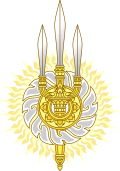
Buddha Yodfa Chulaloke Buddha Loetla Nabhalai Jessadabodindra Mongkut Chulalongkorn Vajiravudh Prajadhipok Ananda Mahidol Bhumibol Adulyadej - Bhumibol Adulyadej
- Rama (King of Thailand)
- Chakri Dynasty
- Constitution of Thailand
- Privy Council of Thailand
- Government of Thailand
- 1924 Palace Law of Succession
- Grand Palace
Bibliography
- The Constitution of the Kingdom of Thailand (2007), s:2007 Constitution of Thailand
- Aryan, Gothan (September 15-September 16, 2004), Thai Monarchy, International Institute for Democracy and Electoral Assistance, Retrieved on 5 July 2006, presented in Kathmandu, Nepal
- Kullada Kesboonchoo Mead, The Rise and Decline of Thai Absolutism, RoutledgeCurzon 2004
References
- ^ http://news.bbc.co.uk/2/hi/asia-pacific/7128935.stm
- ^ http://www.thailawonline.com/en/others/criminal-law
- ^ Fuller, Thomas (May 27, 2011). "American Arrested for Insulting Thai King". The New York Times. http://www.nytimes.com/2011/05/28/world/asia/28thai.html. Retrieved May 28, 2011. "using the Internet to disseminate information that insults or threatens the monarchy"
- ^ http://www.photius.com/countries/thailand/government/thailand_government_the_king.html
- ^ http://sunsite.au.ac.th/thailand/thai_monarchy/background.html
- ^ http://web.archive.org/web/20091027073704/http://geocities.com/threeb.rm/regalia.html
- ^ a b Thai Government Public Relations: Royal Regalia + Royal Utensils.
- ^ http://sunsite.au.ac.th/thailand/thai_monarchy/residence.html
- ^ http://www.pattayamail.com/457/news.shtml
External links
- King of Thailand.net
- Website of the King's 50 Anniversary Celebration
- The illustrious Chakri family
- The Royal Family, History and Information
- Website on the Thai Monarchy
Leaders of present-day Southeast Asian countries Heads of state Brunei (Monarch) · East Timor (President) · Cambodia (Monarch) · Indonesia (President) (list) · Laos (President) · Malaysia (Monarch) · Myanmar (President) (list) · Papua New Guinea (Monarch) · Philippines (President) (list) · Singapore (President) · Thailand (Monarch) (list) · Vietnam (President)Heads of government Brunei · Cambodia · East Timor · Indonesia (list) · Laos · Malaysia · Myanmar · Papua New Guinea · Philippines (list) · Singapore · Thailand (list) · VietnamDefunct heads of state and government ASEAN Links to related articles Monarchs of Thailand (List) Sukhothai Kingdom
(1238-1438)Sri Indraditya · Ban Muang · Ram Khamhaeng · Lerthai · Nguanamthom · Lithai · Leuthai · Saileuthai · Borommapan
Ayutthaya Kingdom
(1350-1767)Uthong · Ramesuan · Borommarachathirat I · Thong Lan · Rama Ratchathirat · Intha Racha · Borommarachathirat II · Trailokanat · Borommarachathirat III · Ramathibodi II · Borommarachathirat IV · Ratsadathirat · Chairacha · Yodfa · Worawongsathirat · Maha Chakkraphat · Mahinthrathirat · Maha Thammarachathirat · Naresuan · Ekathotsarot · Si Saowaphak · Songtham · Chetthathirat · Athittayawong · Prasat Thong · Chao Fa Chai · Si Suthammaracha · Narai · Phetracha · Suriyenthrathibodi · Thai Sa · Boromakot · Uthumphon · Ekkathat
Thonburi Kingdom
(1768-1782)Rattanakosin Kingdom, later Thailand
(1782-)Buddha Yodfa Chulalok · Buddha Loetla Nabhalai · Jessadabodindra · Mongkut · Chulalongkorn · Vajiravudh · Prajadhipok · Ananda Mahidol · Bhumibol Adulyadej (current)
Queens and Consorts of the Chakri Dynasty 
 Fourth ReignSoamanas Vadhanavadi • Debsirindra • PannaraiFifth ReignSunandha Kumariratana • Sukhumala Marasri • Savang Vadhana • Saovabha BongsriSixth ReignLaksamilawan • Sucharit Suda • Indrasakdi Sachi • SuvadhanaSeventh ReignRambhai BarniNinth Reign (current)Sirikit (current)
Fourth ReignSoamanas Vadhanavadi • Debsirindra • PannaraiFifth ReignSunandha Kumariratana • Sukhumala Marasri • Savang Vadhana • Saovabha BongsriSixth ReignLaksamilawan • Sucharit Suda • Indrasakdi Sachi • SuvadhanaSeventh ReignRambhai BarniNinth Reign (current)Sirikit (current)Bold indicate Queen Consorts; the others indicate Princess Consorts. Crown Princes of Thailand 
Fifth Reign 
Ninth Reign Vajiralongkorn (current)Vajirunhis died in 1895, before he could succeed to the throne Front Palace of the Chakri Dynasty 
 Third ReignFourth ReignPinklao (Did not become King but was given the styles and titles of a King.)Fifth ReignVichaichan (Title abolished after death.)
Third ReignFourth ReignPinklao (Did not become King but was given the styles and titles of a King.)Fifth ReignVichaichan (Title abolished after death.)In 1885, the title was replaced with the Crown Prince of Siam Categories:- Thai monarchy
Wikimedia Foundation. 2010.

